Chop marks and test cuts
 MilkmanDan
Posts: 3,764 ✭✭✭✭✭
MilkmanDan
Posts: 3,764 ✭✭✭✭✭
Another thread today discussed test drill marks and it's a good time to summarize the different types of marks imparted on coins for trade purposes primarily in the orient. Frank Rose, often referred to as the godfather of chop mark coin collecting wrote a book (more like a pamphlet) on the topic.
Rose lists the following types of chop marks in his book:
1. Test marks
2. Edge Cuts
3. Small Chops
4. Large Chops
5. Chops in Relief
6. Assay Chops
7. Letter Chops
8. Number Chops
9. Manchu Chops
10. Banker's ink chops
11. Paper chops
12. Presentation chops
As far as purpose, I think Rose summarizes it best...
"Basically, chopmarks were counterstamps of Chinese merchants and bankers, stamped on coins as a defense against debased counterfeit coins"
The earlier thread specifically discussed test marks and their relation to chop marks. While chop marks using chinese characters were used to certify a coin as proper weight and fineness, test marks were used to confirm a coin hadn't been altered, as described by Rose:
"There were two purposes for the test marks. The first was testing to see if the coin was a silver plated base metal counterfeit, or to test the coin to see if it had been hollowed out. There were expert silver theives who drilled in from the edge of coins, hollowing out the coin. To bring the coins back to something like full weight, they would pour in lead or a base metal alloy, or they would fill the hollow with a very heavy clay. The large , heavily struck, test marks were meant to reveal such thefts."
I think most people have seen a chop marked coin with chinese characters, but are not likely as familiar with test marks. Here are some examples.
Drill mark, also referred to as "trifoil" mark on these forums
I have seen these drill marks on 8 reales, trade dollars as well as seated halves.

another in the right obverse field (photo courtesy of Crypto79)
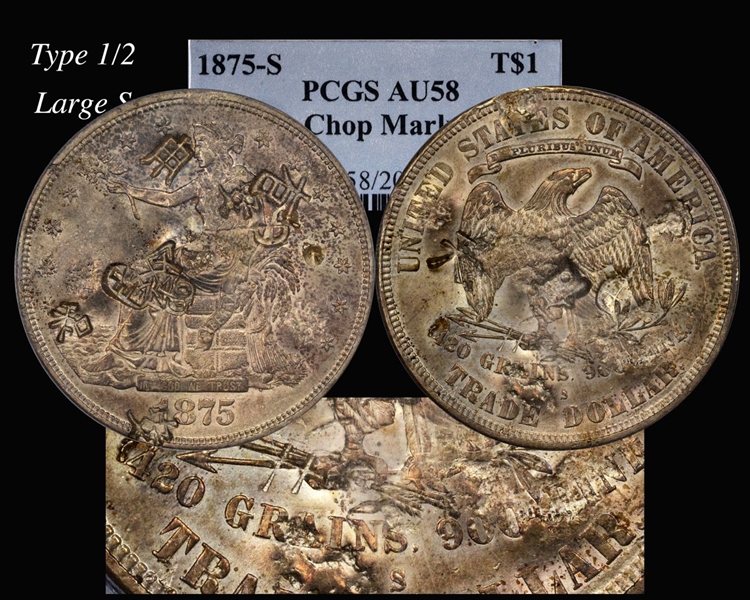
Two obverse drill marks (photo courtesy of Coinfacts)
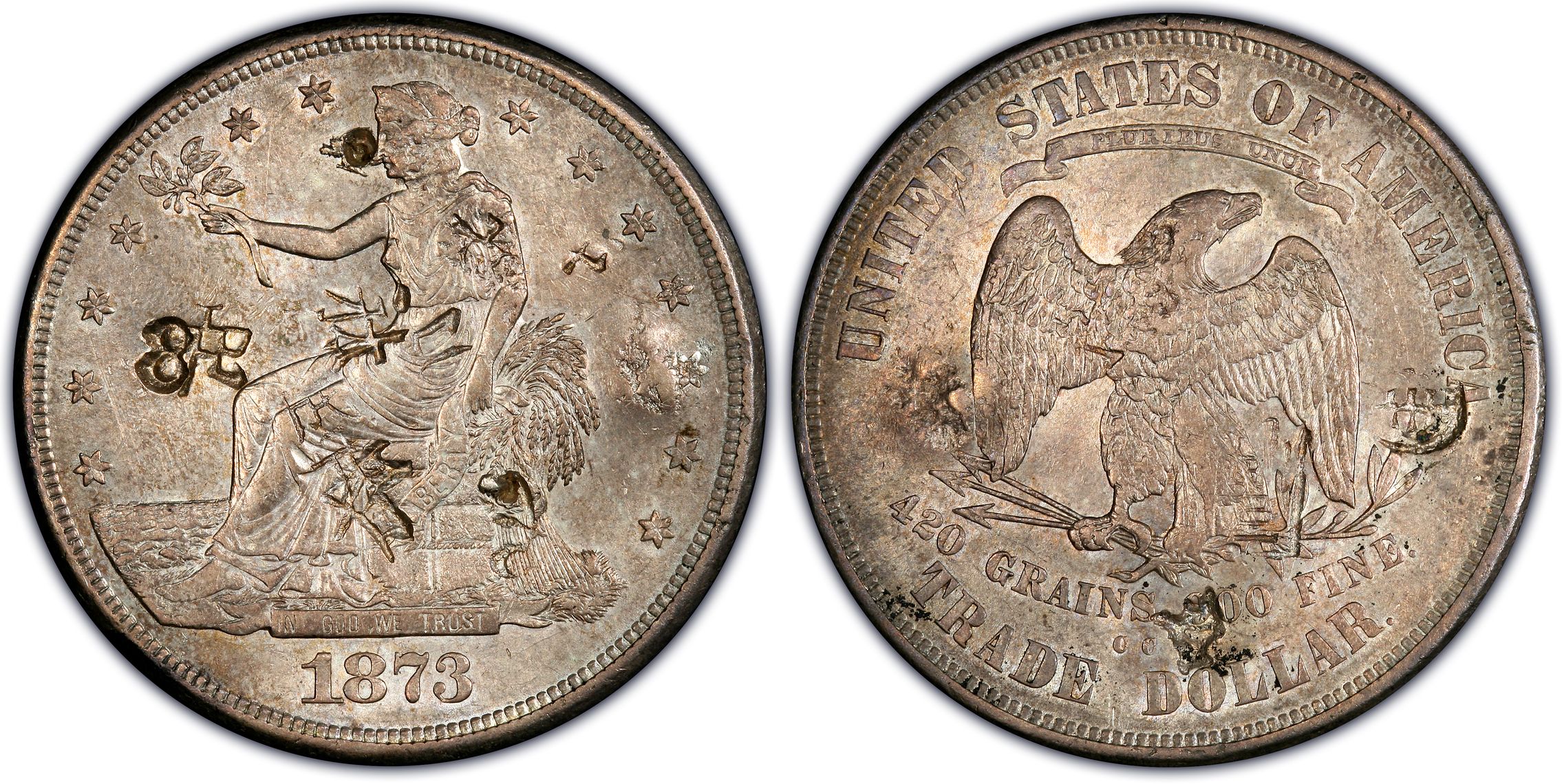
Single obverse drill mark (photo courtesy of Coinfacts)
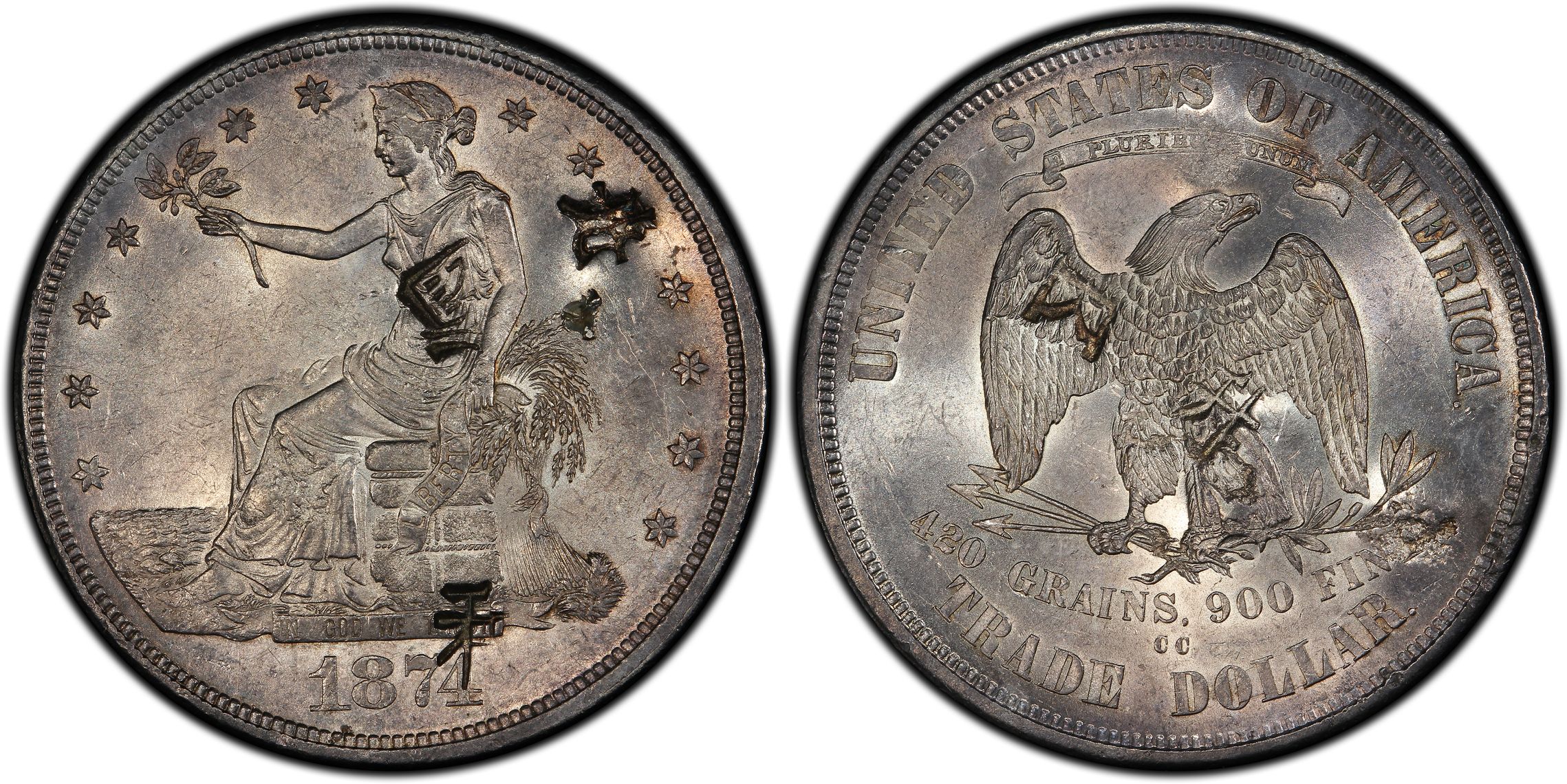
Sometimes these marks were made with some kind of drill tool as above, evidenced by the metal tabs and circular pattern inside the mark. Other times the hole was made by a punch, as shown in a few places on this example:

Here's another with a square shaped punch mark near the center obverse, along with a few other tiny punch marks (photo courtesy of Coinfacts)
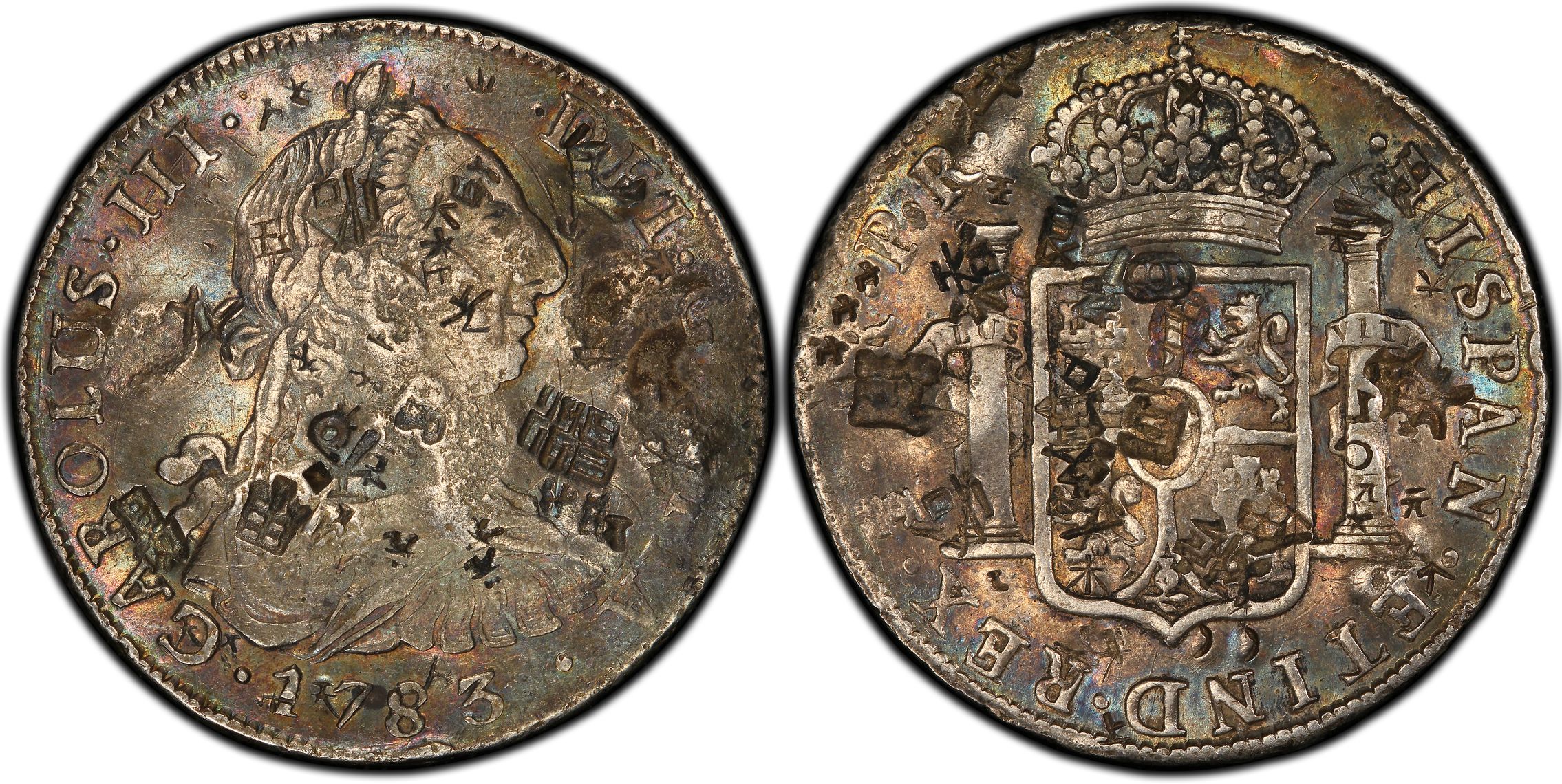
My observation is that these punched test marks were common back in the late 1700's to early 1800's whereas the drilled test marks were more common in the mid to latter part of the 1800's.
Chisel mark or test cut in field
Liberty with lobotomy (photo courtesy of Crypto79)
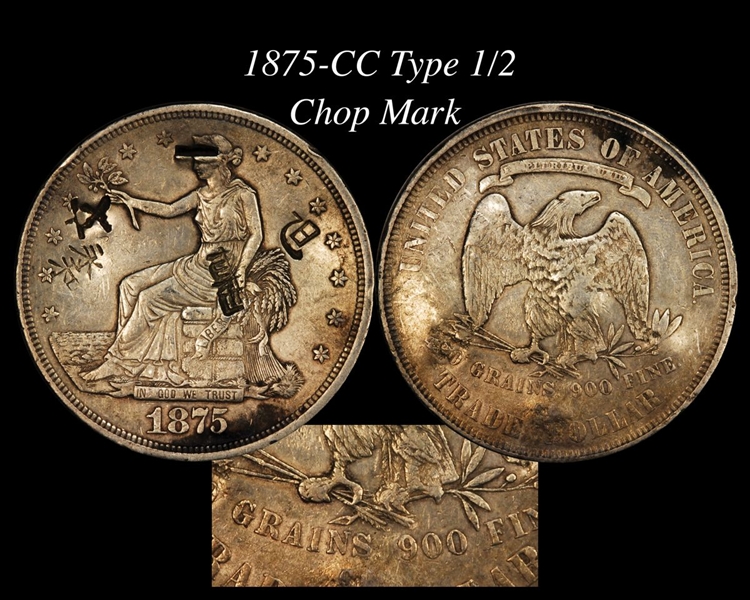
Large reverse chisel test mark and obverse drill mark (photo courtesy of Coinfacts)
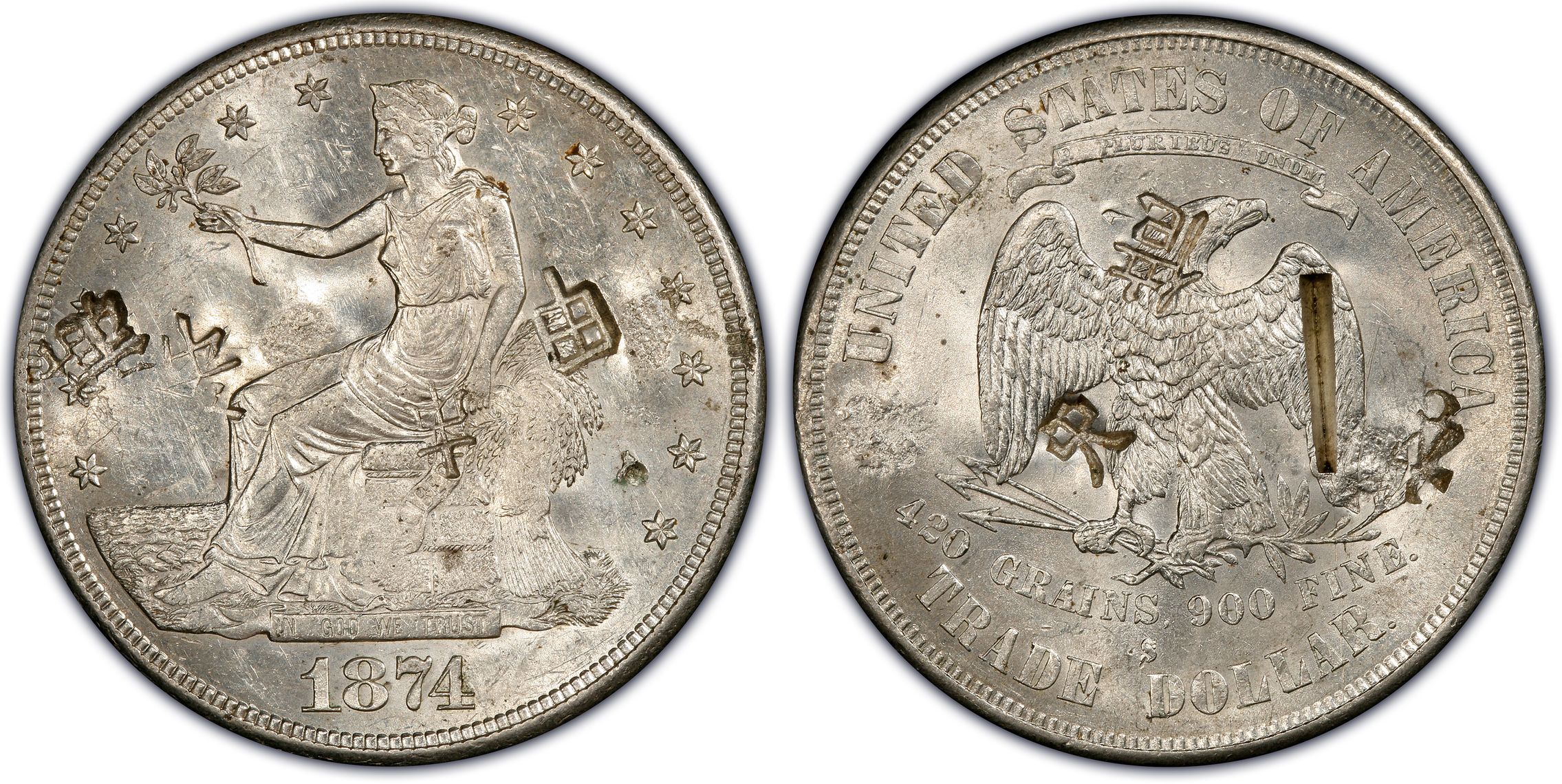
Edge cut
I haven't seen as many of these around, I think they are less common, or possibly more discarded due to the severity of the damage.
Here's an example of an ancient with edge cut (image courtesy of Stack's)

I had trouble finding any more recent pictures of edge cut test marks, although Messydesk has a nice little picture here.
I would say that overall, chop marked trade dollars as well as other chop marked coins are more common without the test marks than with. This is possibly because the examples with test marks are viewed as more damaged and were melted or discarded. Feel free to post more examples of any of these kind of test marks if you have them. It's worth noting that there isn't much period documentation about the tools used to make these marks and as far as I've heard from the experts, no one has ever located a tool used to make a chop mark on a coin.
Rose lists the following types of chop marks in his book:
1. Test marks
2. Edge Cuts
3. Small Chops
4. Large Chops
5. Chops in Relief
6. Assay Chops
7. Letter Chops
8. Number Chops
9. Manchu Chops
10. Banker's ink chops
11. Paper chops
12. Presentation chops
As far as purpose, I think Rose summarizes it best...
"Basically, chopmarks were counterstamps of Chinese merchants and bankers, stamped on coins as a defense against debased counterfeit coins"
The earlier thread specifically discussed test marks and their relation to chop marks. While chop marks using chinese characters were used to certify a coin as proper weight and fineness, test marks were used to confirm a coin hadn't been altered, as described by Rose:
"There were two purposes for the test marks. The first was testing to see if the coin was a silver plated base metal counterfeit, or to test the coin to see if it had been hollowed out. There were expert silver theives who drilled in from the edge of coins, hollowing out the coin. To bring the coins back to something like full weight, they would pour in lead or a base metal alloy, or they would fill the hollow with a very heavy clay. The large , heavily struck, test marks were meant to reveal such thefts."
I think most people have seen a chop marked coin with chinese characters, but are not likely as familiar with test marks. Here are some examples.
Drill mark, also referred to as "trifoil" mark on these forums
I have seen these drill marks on 8 reales, trade dollars as well as seated halves.

another in the right obverse field (photo courtesy of Crypto79)

Two obverse drill marks (photo courtesy of Coinfacts)

Single obverse drill mark (photo courtesy of Coinfacts)

Sometimes these marks were made with some kind of drill tool as above, evidenced by the metal tabs and circular pattern inside the mark. Other times the hole was made by a punch, as shown in a few places on this example:

Here's another with a square shaped punch mark near the center obverse, along with a few other tiny punch marks (photo courtesy of Coinfacts)

My observation is that these punched test marks were common back in the late 1700's to early 1800's whereas the drilled test marks were more common in the mid to latter part of the 1800's.
Chisel mark or test cut in field
Liberty with lobotomy (photo courtesy of Crypto79)

Large reverse chisel test mark and obverse drill mark (photo courtesy of Coinfacts)

Edge cut
I haven't seen as many of these around, I think they are less common, or possibly more discarded due to the severity of the damage.
Here's an example of an ancient with edge cut (image courtesy of Stack's)

I had trouble finding any more recent pictures of edge cut test marks, although Messydesk has a nice little picture here.
I would say that overall, chop marked trade dollars as well as other chop marked coins are more common without the test marks than with. This is possibly because the examples with test marks are viewed as more damaged and were melted or discarded. Feel free to post more examples of any of these kind of test marks if you have them. It's worth noting that there isn't much period documentation about the tools used to make these marks and as far as I've heard from the experts, no one has ever located a tool used to make a chop mark on a coin.
1
Comments
Interesting note the 75s you posted of mine has a obvious drill hole on the obv but another one of the same style on the rev by the 420. Not sure why a 2nd was employed accept maybe raising the explanation that it might be more of an simplistic chop rather than a testing cut. Even the cuts might be more stylized than functional, much of even rose's work is assumed
<< <i>Great post Dan and I agree with most everything. My main point of divergence is while anti counterfeiting being one of the benefits provided by the chops I think it was at its core a tax and accounting system as way to validate what passed through the proper hands.
Interesting note the 75s you posted of mine has a obvious drill hole on the obv but another one of the same style on the rev by the 420. Not sure why a 2nd was employed accept maybe raising the explanation that it might be more of an simplistic chop rather than a testing cut. Even the cuts might be more stylized than functional, much of even rose's work is assumed >>
That's a good point, why the need for multiple test marks if they were used for authentication? Then again, why the need for multiple chop marks like with the example below.
I've seen much worse, where the coin actually broke apart or was so chopped that it formed a cupped shape. I could see a scenario where one merchant saw his buddies chop marks (or rival merchants) on a coin and decided to put his chop over that one, and so on. Your scenario is likely more accurate, at least with the Canton system it was very well regulated with many checkpoints along the way that probably included chopping of silver.
<< <i>Great post Dan and I agree with most everything. My main point of divergence is while anti counterfeiting being one of the benefits provided by the chops I think it was at its core a tax and accounting system as way to validate what passed through the proper hands.
Interesting note the 75s you posted of mine has a obvious drill hole on the obv but another one of the same style on the rev by the 420. Not sure why a 2nd was employed accept maybe raising the explanation that it might be more of an simplistic chop rather than a testing cut. Even the cuts might be more stylized than functional, much of even rose's work is assumed >>
Interesting bit about the taxing functionality of such chisel test marks. It does appear that quite a bit of metal was removed, although I can't fathom how a blunt object could be used to achieve any more than flattening the adjacent metal (which clearly didn't happen).
Dan, I had always learned from my relatives that the chops were used as the "accounting system" crypto mentioned. I would guess that a merchant would receive a shipment of Trade Dollars and chop a handful of them out of the lot. They certainly didn't chop every single coin that came to them, or the United States government would never advertise to the Orient that they would repurchase all the unchopped coinage they had. I would take your guess over any other as to why some coins had so many chops, although another possibility is that large merchants had multiple employees verify shipments of Trade Dollars, resulting in many chops on a single coin or few coins that signified that the entire lot had been checked by such and such employee. This would also explain the relative lack of variety in chop marks on Trade Dollars, as one would expect so many merchants with unique chops would result in a much wider series of Chops that doesn't seem to be the case.
<< <i>Great Job Dan, it certainly ties it all together in one unified thread, thanks for taking the time!
Here are three more pics of test drills from HA.com, don't think it will come out but I tried:
Here's a close-up of the drill mark from one of these coins. You can see the circular pattern inside the hole to confirm this was a drill mark and not a punch.
<< <i>What boggles the mind is how many millions of silver pieces passed through hands and how tedious it must have been to hand chop or test each individual coin. Like you said there were likely many pieces that escaped the chopper but still. >>
Dan, I think it would be more likely that entire bags went to the large merchants first, and were later distributed in smaller quantities to smaller merchants. What seems to make sense to me would be that out of an entire bag, a merchant and/or his employees will check each coin, and then chop a few coins out of the entire bag to symbolize that the entire bag is kosher. Then, as they were redistributed in smaller quantities, the smaller merchants themselves will chop a few coins out of the smaller quantity. If every merchant chopped every Trade Dollar, I would take a gander that far more chopmarked Trade Dollars will be offered in the market today than we currently find. I would guess that many unchopped coins still made the trip to the Orient and back.
Then again, this is all speculation
<< <i>
<< <i>Great post Dan and I agree with most everything. My main point of divergence is while anti counterfeiting being one of the benefits provided by the chops I think it was at its core a tax and accounting system as way to validate what passed through the proper hands.
Interesting note the 75s you posted of mine has a obvious drill hole on the obv but another one of the same style on the rev by the 420. Not sure why a 2nd was employed accept maybe raising the explanation that it might be more of an simplistic chop rather than a testing cut. Even the cuts might be more stylized than functional, much of even rose's work is assumed >>
What a ridiculous statement Crypto just made "much of even Rose's work is assumed". Whose word/work isn't assumed. You are the only original thought that exists? Every great expert/writer/researcher thought's that are written are assumed. What they write is according to their own experiences. Holy crap what an egotistical thing to say when you don't want to agree with someone's writings especially when they aren't here to defend themselves. Most coins shown in Rose's were his own that he as writing about, and what he thought were based on those coins and his years of research. >>
I have told my self that it is unbecoming to pick on the handicap but this deserves a response as you seam inclined to derail another thread where grow ups are talking.
You aren't just crazy, your reading comprehension is also special. Nobody discounted Rose's ideas, just yours and that is because you confuse imigination for hypothesis. I have seen the rose collection and talked to one of the principles working on the rewrite of his book not to mention years of reaserch into the subject (as opposed to the savant who can't post pictures) and most people who know what they are talking about understand that very little of that portion of history is clearly recorded and the normal scientific burden of proof is all but unattainable. That doesn't give permission to the clueless to just fill in the blanks.
<< <i>
<< <i>Great post Dan and I agree with most everything. My main point of divergence is while anti counterfeiting being one of the benefits provided by the chops I think it was at its core a tax and accounting system as way to validate what passed through the proper hands.
Interesting note the 75s you posted of mine has a obvious drill hole on the obv but another one of the same style on the rev by the 420. Not sure why a 2nd was employed accept maybe raising the explanation that it might be more of an simplistic chop rather than a testing cut. Even the cuts might be more stylized than functional, much of even rose's work is assumed >>
What a ridiculous statement Crypto just made "much of even Rose's work is assumed". Whose word/work isn't assumed. You are the only original thought that exists? Every great expert/writer/researcher thought's that are written are assumed. What they write is according to their own experiences. Holy crap what an egotistical thing to say when you don't want to agree with someone's writings especially when they aren't here to defend themselves. Most coins shown in Rose's were his own that he as writing about, and what he thought were based on those coins and his years of research. >>
Please don't poop on my thread with personal arguments.
I believe what he was (accurately according to Rose) saying is that there is hardly any documentation about chop marked coins and so even Rose who studied them more than just about anyone didn't have a lot of documentation to back up his assumptions. He made that pretty clear up front in his book.
<< <i>I am challenged in all respects. >>
<< <i>Getting back to the matter at hand, my half disme matches your great close-up of the test drill, however I also have a Liberty Seated Dollar that was punched and not drilled as well as a chopmark. I will be getting mark Goodman to photograph it in the near future since I am technically challenged in all respects. >>
If you're suggesting that your half disme went to the Orient and circulated as currency there, I think you are out to lunch. Not only did it have a non-standard weight, the confusing legends would have proved to been even more of a challenge for already English-illiterate merchants.
I'd like to understand better the notion that chopmarks served as a tax and accounting method, moreso than a validation of acceptable coinage. What does this mean? Merchants approved pieces at some discount? What was taxed? Sorry if these are dumb questions.
Lance.
<< <i>
<< <i>
<< <i>Getting back to the matter at hand, my half disme matches your great close-up of the test drill, however I also have a Liberty Seated Dollar that was punched and not drilled as well as a chopmark. I will be getting mark Goodman to photograph it in the near future since I am technically challenged in all respects. >>
If you're suggesting that your half disme went to the Orient and circulated as currency there, I think you are out to lunch. Not only did it have a non-standard weight, the confusing legends would have proved to been even more of a challenge for already English-illiterate merchants. >>
Not at all at this time although it was a theory by a chopmark expert that I consulted with and seriosulyconsidered, however now I believe it was done in America since only approx. 1500 were minted and would not be very familiar with the common day citizens, I mean how many Americans in 1792 and later actually got to see an example in hand. I could see a merchant of some sort get it and not know what it was exactly. I definitely don't believe someone tried to make a hole for jewelry since it is far easier to make a hole than stop at only the point of a test drill on a coin that thin and small. >>
Realone, thanks for the clarification. That makes much more sense and is certainly more plausible. With this laid out, I don't personally see much more room for debate at this point seeing that anything beyond this is speculation (whether test mark or attempted jewelry). Let's move on from this subject and sing kumbaya...
<< <i>I'd like to understand better the notion that chopmarks served as a tax and accounting method, moreso than a validation of acceptable coinage. What does this mean? Merchants approved pieces at some discount? What was taxed? Sorry if these are dumb questions.
Lance. >>
Lance, if I am understanding your question correctly, I will try to answer your question. There were many counterfeits and underweight (shaved) coinage those days, so a chopmark was a symbol that the coin (and in my opinion the coins that it came with) were all acceptable and of the correct weight. I don't really know much about the taxing, and I would guess that crypto was speculating on the nature of such large and non-artistic chopmarks.
Let's also not forget that our very own DDR has assembled the finest chop mark Trade Dollar set, viewable here.. Dave even has a few Ex-Rose coins in his collection, including a chop marked version of the super rare 1875 1/1 Trade Dollar.
I'm working on a set that some may find interesting, it's meager compared to the greats but I'm off to a great start (about 8 months into it). Viewable here.
I think it's worth posting a follow-up showing DDR's awesome 1875 Trade Dollar. (DDR, hope you don't mind). Notice this coin shows the following test marks:
1. Obverse drill mark
2. Multiple obverse square punch marks
3. Reverse chisel-like chop that actually pulls up the metal around GRAINS on the reverse.
Interesting why a single coin would need this many test marks, if indeed they were used for authentication. Lends weight to the theory that these were just another type of chop mark, of the quick and dirty variety.
If only the choppers had known just how rare this coin is...
A punch is simply going to leave a hole, with maybe a little smooth metal pushed up around the edges, but it should look different, like this.
Edit:
Take your least favorite coin and go try it out for yourself in the garage. I bet you'll see similar results.
REVIVING OLD THREAD ALERT
I was going through some old literature and came across an article from Coins Magazine written by Mark Benvenuto (editor of the Chopmark Collectors Club for a time in the early 90's). The article is titled "Why were coins 'chopmarked?'" (published September 1992, vol. 39, No. 9, pgs. 72, 74-77). In this article the author states:
"With labor rates so low in 19th century China, it was profitable to have a worker take a tiny bit of silver from each coin with a drill, then pass the coin on at full weight and value...If he did it to enough coins, a person could accumulate enough silver to make money by remelting the combined shavings."
@TDN I believe this describes the 'trifoil' mark we've previously discussed, the mark which you have gotten PCGS to deem acceptable when grading chopmarked trade dollars.
Question? 1875 1/1 Super rare? Will you please suggest where I can look to back this up? Thanks!
The 1875-P Type 1/1 is one of the true keys to the hub type set for the Trade Dollar series. The most current edition of the Whitman 'Guide Book of Liberty Seated Silver Coins' by QDB cites on pg. 495 the 75-P Type 1/1, in a study by Mark Borckardt (comprising several thousand auction appearances), as comprising 10% of the total business strike mintage of 218,200. He further states that the issue is "very rare" with chopmarks, and claims an estimated survival rate of all coins (w/o chops) of just 25 to 35 in circulated grades, 2 to 4 in uncirculated. Many of the attributed 75-P examples with chopmarks also conveniently have damage around the mintmark area and do not match the die characteristics of genuine 75-P specimens (many exhibit specific die cracks and boars member Crypto has also noted a patch of unpolished die around the eagle's right claw which he believes originates from the master hub).
25-35. Lol
I apologize, that was poorly worded. The estimate of 25 to 35 examples corresponds to the 1875-P in all circulated grades, without chops.
I apologize, that was poorly worded. The estimate of 25 to 35 examples corresponds to the 1875-P Type 1/1 in all circulated grades, without chops.
Interesting thread, a pleasure to re-read.
I once did a study of the relative scarcity of the different obverse/reverse Trade Dollar combinations, which was published in the Gobrecht Journal. I found that for the 75-P, the ratio was about 20:1 of Type I/II to Type I/I. And there are very few 75-P Trade Dollars to start with, so the I/I is very rare.
Thanks for resurecting this thread, Dan.
Complete Set of Chopmarked Trade Dollars
Carson City Silver Dollars Complete 1870-1893http://www.pcgs.com/setregistry/showcase.aspx?sc=2722"
I also agree with Rose and others that the "trifoil" chop, we sometimes see on Trade Dollars, was used to steal a bit of silver from each coin.
Complete Set of Chopmarked Trade Dollars
Carson City Silver Dollars Complete 1870-1893http://www.pcgs.com/setregistry/showcase.aspx?sc=2722"
Thank you for taking the time to spell out the answer. I just cannot believe only 25-35 w/o chops exist.
Well, I'm a believer now. Just looked on Ebay and only 2 1875's and no 1/1. There is a nice Proof.
@DDR said: "I once did a study of the relative scarcity of the different obverse/reverse Trade Dollar combinations, which was published in the Gobrecht Journal. "
Care to tell which of the combined volumes it is in?
I believe there are ZERO legitimate 1875-P coins WITH chops
I just looked up some old Gobrecht Journal articles. The 1875 1/1 was unknown to Fazzari when he published a chart of varieties in1994. He had seen over a thousand Trade dollars by then including two large collections. Joe K., a LSCC member, verified their existence in a letter to the editor. Seems all 1875's are elusive when compared to other dates. I have heard the 1873 is tough also.
Two purported 1875 1/1 have sold on Ebay over the past month or two. One was in an NGC AU Details-Cleaned slab. It looked like an impaired proof to me with squared rims among other signs, so I passed on it. It went for $1k. A second one, in a PCGS AU Details-Cleaned slab sold for $1500 on July 7. It was heavily scrubbed, but appeared to me to be a genuine Business Strike. I thought about this one, but apparently too long as it went pretty quickly. Both coins sold withing 24-48 hours of being listed. That gives you an idea of the demand - two problem coins with no trouble selling.
mbogoman
https://pcgs.com/setregistry/collectors-showcase/classic-issues-colonials-through-1964/zambezi-collection-trade-dollars/7345Asesabi Lutho
A great old thread with lots of info, thanks for reviving it
Successful transactions with : MICHAELDIXON, Manorcourtman, Bochiman, bolivarshagnasty, AUandAG, onlyroosies, chumley, Weiss, jdimmick, BAJJERFAN, gene1978, TJM965, Smittys, GRANDAM, JTHawaii, mainejoe, softparade, derryb, Ricko
Bad transactions with : nobody to date